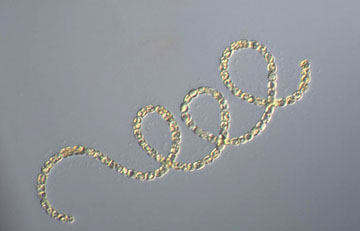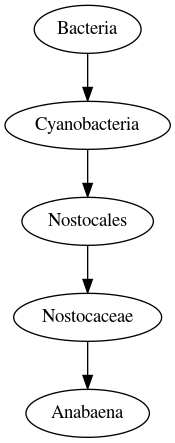Anabaena: различия между версиями
Материал из Поле цифровой дидактики
Patarakin (обсуждение | вклад) |
|||
| (не показано 10 промежуточных версий 2 участников) | |||
| Строка 1: | Строка 1: | ||
{{Microbs | {{Microbs | ||
|Description= | |Description=Анабена (лат. Anabaena) — род нитчатых цианобактерий (синезелёных водорослей), входит в состав планктона. Клетки округлые или бочонковидные, имеются гетероцисты. Для анабены характерно наличие специализированных клеток для переживания неблагоприятного периода – акинет. Известны своими азотфиксирующими способностями, образуют симбиотические отношения с определёнными растениями, такими, как некоторые папоротники. Являются одними из четырёх родов цианобактерий, которые производят нейротоксины, наносящими ущерб местной дикой природе, а также сельскохозяйственным и домашним животным.. | ||
|Higher order taxa=Bacteria | |Higher order taxa=Bacteria, Cyanobacteria, Nostocales, Nostocaceae, Anabaena | ||
|Species=*''Anabaena abnormis'' Proskina-Lavrenko & Makarova | |Species= | ||
* ''Anabaena abnormis'' Proskina-Lavrenko & Makarova | |||
* ''Anabaena aequalis'' Borge | * ''Anabaena aequalis'' Borge | ||
* ''Anabaena aequalis'' f. ''anomala'' Kossinska | * ''Anabaena aequalis'' f. ''anomala'' Kossinska Kossinskaya | ||
* ''Anabaena aerophila'' Brabez | * ''Anabaena aerophila'' Brabez | ||
* ''Anabaena aeruginosa'' N.L.Gardner | * ''Anabaena aeruginosa'' N.L.Gardner | ||
| Строка 205: | Строка 206: | ||
* Anabaena willei N.L.Gardner | * Anabaena willei N.L.Gardner | ||
* Anabaena wisconsinensis Prescott | * Anabaena wisconsinensis Prescott | ||
* Anabaena woodii G.De Toni | * Anabaena woodii G.De Toni<br> | ||
|Genome Structure=The genome of the circular chromosome of the PCC 7120 strain of Anabaena has been sequenced. It contains 1 chromosome with 6,413,771 base pairs with 5,368 predicted protein-coding regions, and six plasmids ranging from 408,101 base pairs to 5,584 base pairs. The sequencing of the anabaena genome will aid researchers in studying the genetics and physiology of cellular differentiation, (as exhibited in the heterocycsts of Anabaena) pattern formation, and nitrogen fixation. | |Genome Structure=The genome of the circular chromosome of the PCC 7120 strain of Anabaena has been sequenced. It contains 1 chromosome with 6,413,771 base pairs with 5,368 predicted protein-coding regions, and six plasmids ranging from 408,101 base pairs to 5,584 base pairs. The sequencing of the anabaena genome will aid researchers in studying the genetics and physiology of cellular differentiation, (as exhibited in the heterocycsts of Anabaena) pattern formation, and nitrogen fixation. | ||
|Cell Structure=During times of low environmental nitrogen, about one cell out of every ten will differentiate into a heterocyst. Heterocysts then supply neighboring cells with fixed nitrogen in return for the products of photosynthesis, that they can no longer perform. This separation of functions is essential because the nitrogen fixing enzyme in heterocysts, nitrogenase, is unstable in the presence of oxygen. | |Cell Structure=During times of low environmental nitrogen, about one cell out of every ten will differentiate into a heterocyst. Heterocysts then supply neighboring cells with fixed nitrogen in return for the products of photosynthesis, that they can no longer perform. This separation of functions is essential because the nitrogen fixing enzyme in heterocysts, nitrogenase, is unstable in the presence of oxygen. | ||
|Ecology=It is commonly accepted that cyanobacteria played a key role in the manufacturing of oxygen during the Precambrian period of earth's history. They perform oxygenic photosynthesis, very similar to that of eukaryotic plants and algae, by utilizing water as a reductant source, consequently producing molecular oxygen. Heterocysts, mentioned above, are terminally differentiated cells that specialize in nitrogen fixation. It is believed that the capacity for developing heterocysts first developed when the concentration of oxygen in the atmosphere (largely produced by cyanobacteria) reached levels high enough to cause the inactivation of the nitrogen-fixing enzyme nitrogenase. | |Ecology=It is commonly accepted that cyanobacteria played a key role in the manufacturing of oxygen during the Precambrian period of earth's history. They perform oxygenic photosynthesis, very similar to that of eukaryotic plants and algae, by utilizing water as a reductant source, consequently producing molecular oxygen. Heterocysts, mentioned above, are terminally differentiated cells that specialize in nitrogen fixation. It is believed that the capacity for developing heterocysts first developed when the concentration of oxygen in the atmosphere (largely produced by cyanobacteria) reached levels high enough to cause the inactivation of the nitrogen-fixing enzyme nitrogenase. | ||
}} | }} | ||
'''Анабена''' (лат. ''Anabaena'') — род нитчатых [[Цианобактерии|цианобактерий]] (синезелёных водорослей), входит в состав [[планктон]]а. Клетки округлые или бочонковидные, имеются [[гетероцисты]]. Для анабены характерно наличие специализированных клеток для переживания неблагоприятного периода – [[Акинеты|акинет]]. Известны своими [[Азотфиксация|азотфиксирующими способностями]], образуют [[Симбиоз|симбиотические отношения]] с определёнными растениями, такими, как некоторые [[папоротники]]. Являются одними из четырёх родов цианобактерий, которые производят [[нейротоксин]]ы, наносящими ущерб местной дикой природе, а также сельскохозяйственным и домашним животным. | |||
https://microbewiki.kenyon.edu/index.php/Anabaena | https://microbewiki.kenyon.edu/index.php/Anabaena | ||
Текущая версия на 21:05, 29 октября 2022
| Описание микроба | Анабена (лат. Anabaena) — род нитчатых цианобактерий (синезелёных водорослей), входит в состав планктона. Клетки округлые или бочонковидные, имеются гетероцисты. Для анабены характерно наличие специализированных клеток для переживания неблагоприятного периода – акинет. Известны своими азотфиксирующими способностями, образуют симбиотические отношения с определёнными растениями, такими, как некоторые папоротники. Являются одними из четырёх родов цианобактерий, которые производят нейротоксины, наносящими ущерб местной дикой природе, а также сельскохозяйственным и домашним животным.. |
|---|---|
| Верхний таксон | Bacteria, Cyanobacteria, Nostocales, Nostocaceae, Anabaena |
| Species - виды | [[Species::* Anabaena abnormis Proskina-Lavrenko & Makarova
|
| Genome Structure= структура генома | The genome of the circular chromosome of the PCC 7120 strain of Anabaena has been sequenced. It contains 1 chromosome with 6,413,771 base pairs with 5,368 predicted protein-coding regions, and six plasmids ranging from 408,101 base pairs to 5,584 base pairs. The sequencing of the anabaena genome will aid researchers in studying the genetics and physiology of cellular differentiation, (as exhibited in the heterocycsts of Anabaena) pattern formation, and nitrogen fixation. |
| Cell Structure - клеточная структура | During times of low environmental nitrogen, about one cell out of every ten will differentiate into a heterocyst. Heterocysts then supply neighboring cells with fixed nitrogen in return for the products of photosynthesis, that they can no longer perform. This separation of functions is essential because the nitrogen fixing enzyme in heterocysts, nitrogenase, is unstable in the presence of oxygen. |
| Ecology= экология обитания | It is commonly accepted that cyanobacteria played a key role in the manufacturing of oxygen during the Precambrian period of earth's history. They perform oxygenic photosynthesis, very similar to that of eukaryotic plants and algae, by utilizing water as a reductant source, consequently producing molecular oxygen. Heterocysts, mentioned above, are terminally differentiated cells that specialize in nitrogen fixation. It is believed that the capacity for developing heterocysts first developed when the concentration of oxygen in the atmosphere (largely produced by cyanobacteria) reached levels high enough to cause the inactivation of the nitrogen-fixing enzyme nitrogenase. |
Анабена (лат. Anabaena) — род нитчатых цианобактерий (синезелёных водорослей), входит в состав планктона. Клетки округлые или бочонковидные, имеются гетероцисты. Для анабены характерно наличие специализированных клеток для переживания неблагоприятного периода – акинет. Известны своими азотфиксирующими способностями, образуют симбиотические отношения с определёнными растениями, такими, как некоторые папоротники. Являются одними из четырёх родов цианобактерий, которые производят нейротоксины, наносящими ущерб местной дикой природе, а также сельскохозяйственным и домашним животным.
https://microbewiki.kenyon.edu/index.php/Anabaena


